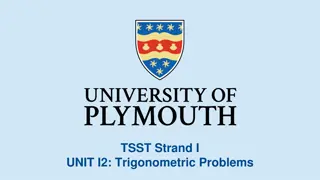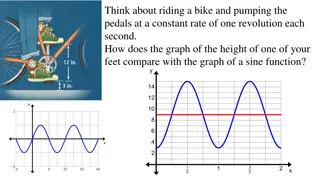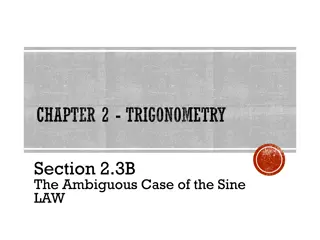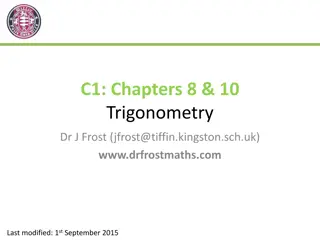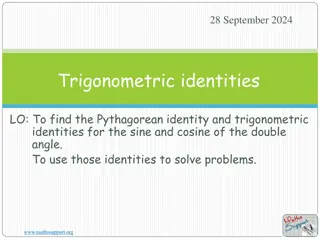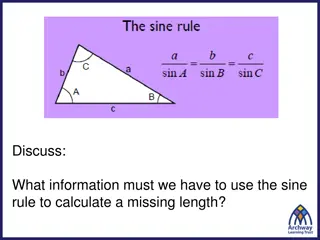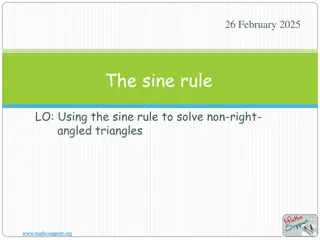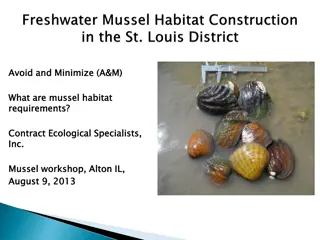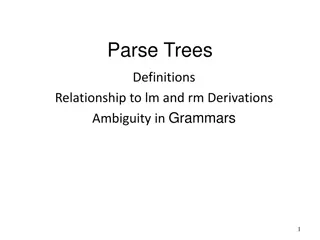
Sine Rule Ambiguous Case Solving Triangles
Learn how to apply the sine rule to solve triangle problems, especially in the ambiguous case where there can be multiple solutions. Understand how to find missing sides and angles using the sine rule with detailed examples and explanations.
Download Presentation

Please find below an Image/Link to download the presentation.
The content on the website is provided AS IS for your information and personal use only. It may not be sold, licensed, or shared on other websites without obtaining consent from the author. If you encounter any issues during the download, it is possible that the publisher has removed the file from their server.
You are allowed to download the files provided on this website for personal or commercial use, subject to the condition that they are used lawfully. All files are the property of their respective owners.
The content on the website is provided AS IS for your information and personal use only. It may not be sold, licensed, or shared on other websites without obtaining consent from the author.
E N D
Presentation Transcript
2 July, 2025 Extension of the sine rule to the ambiguous case LO: Use the sine rule to solve problems with triangles. www.mathssupport.org
The sine rule The sine rule is a method to calculate sides and angles of any triangle. It is useful for finding the length of one side when all the angles and one other side are known, or finding an angle when two sides and one other angle are known To find a side, use the sine rule written as For any triangle ABC: C b c a = = b a sin B sin C sin A or A B To find an angle, use the sine rule written as c Where ais the length of the side opposite ? bis the length of the side opposite ? cis the length of the side opposite ? sin A a sin B b sin C c = = www.mathssupport.org
Using the sine rule to find side angles If we are given two side lengths in a triangle and the angle opposite one of the given sides, we can use the sine rule to find the angle opposite the other given side. For example: C Find the missing angles and sides in this triangle. Finding angle B 60.4 Using the sine rule: sin B 8 sin B = 8 cm 6 cm sin 46 = 6 73.6 46 8 sin 46 6 A B c 7.25 cm Finding side c 8 sin 46 6 Using the sine rule: c = sin 1 B = 6 B = 73.6 (to 3 s.f.) sin 46 6 sin 60.4 sin 46 c =7.25 cm sin 60.4 Finding angle C c = C = 180 46 - 73.6 C = 60.4 www.mathssupport.org
Using the sine rule to find side angles Find the missing angles and sides in this triangle. Given that B is obtuse, find the angle B C 27.6 Using the sine rule: sin B 8 sin 46 8 cm = 6 6 cm 8 sin 46 6 sin B = 106.4 46 c B A 8 sin 46 6 B must be obtuse = 106.4 3.86 cm sin 1 B = Finding side c B = 73.6 B = 180 - 73.6 Using the sine rule: c = 6 Finding angle C sin 46 6 sin 27.6 sin 46 c =3.86 cm sin 27.6 C = 180 46 106.4 C = 27.6 c = www.mathssupport.org
Using the sine rule to find side lengths What do you notice in these triangles. C C 27.6 60.4 8 cm 8 cm 6 cm 6 cm 106.4 73.6 46 c 46 B A B A c 7.25 cm 3.86 cm At the beginning they have the same values for given angles an sides, but they are two different triangles This known as the ambiguous case. When using the sine rule there can be an ambiguous case if: You are given two sides and a non-included acute angle. The side opposite the given acute angle is the shorter of the two given sides www.mathssupport.org
Using the sine rule to find angles In triangle ABC, AB= 12 cm, BC= 8 cm, and angle A measures 28 . Find, rounded to 1 decimal place the measure of angle C sin C C Not to scale sin 28 = 8 12 sin C = 8 cm 12 sin 28 8 ( ) 8 if acute if obtuse 12 sin 28 28 sin 1 44.8 C = B A 12 cm Since C could be acute or obtuse, C 44.8 or However, we do not reject C 135.2 ,as 135.2 + 28 = 163.2 which means the angle C could be 44.8 or 135.2 This is called the ambiguous case (180 44.8) 135.2 www.mathssupport.org
Using the sine rule to find angles In triangle ABC, AB= 12 cm, BC= 8 cm, and angle A measures 28 . Find, rounded to 1 decimal place the measure of angle C Why it is called the ambiguous case C the angle C could be 44.8 or 135.2 44.8 Drawn to scale ifC 44.8 8 cm B 107.2 If we draw an arc of radius 8 cm from B We have another triangle 107.2 28 A 12 cm C B 8 cm 28 135.2 C 135.2 B 16.8 A B 12 cm There is insufficient information to determine the actual shape of the triangle www.mathssupport.org
Using the sine rule to find angles In triangle KLM, ? ?? measures 52 , LM= 158 m, and KM= 128 m. Find the measure of angle L Using the sine rule: sin L 128 sin L = L sin 52 Not to scale = 158 39.7 128 sin 52 158 128 sin 52 ( ) 158 m sin 1 L = 52 158 M K 128 m L 39.7 if acute if obtuse Since L could be acute or obtuse, L 39.7 or However, we reject L 140.3 as 140.3 + 52 > 180 which is impossible The angle L 39.7 (180 - 39.7) 140.3 www.mathssupport.org
Thank you for using resources from A close up of a cage Description automatically generated For more resources visit our website https://www.mathssupport.org If you have a special request, drop us an email info@mathssupport.org Get 20% off in your next purchase from our website, just use this code when checkout: MSUPPORT_20 www.mathssupport.org

